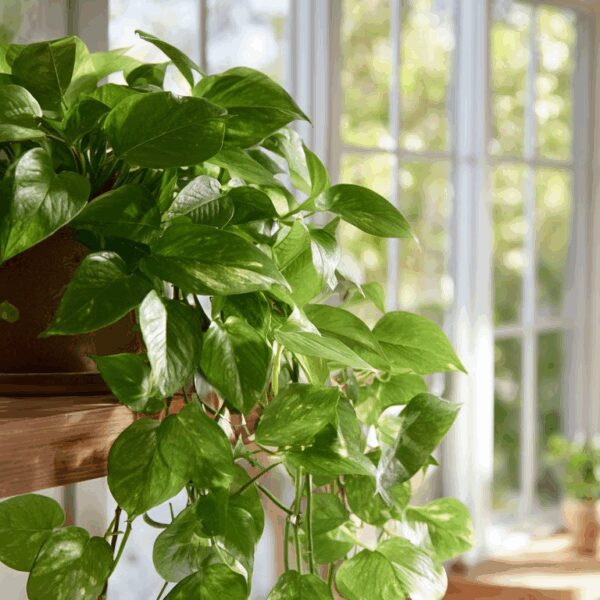Have you ever watched your beautiful succulents droop after a little too much love? Trust me, I’ve been there—overwatering can turn those vibrant greens into sad little blobs. But here’s the secret: bottom watering can work wonders, letting your plants soak up just the right amount without the soggy drama.
🌱 Green Thumb Essentials in 4 Points:
- Bottom Watering Magic 💧: Instead of pouring water on top, try soaking the bottom! Place your pots in a shallow dish for 20-30 minutes. This encourages deeper roots and keeps those pesky fungal issues at bay. Your succulents will thank you!
- Soil Matters 🌿: Choose a well-draining mix, like those made for succulents. Think Miracle-Gro or a DIY blend of 60% potting soil and 40% perlite. It’s all about giving your plants that airy environment they crave.
- Water Wisely ⏰: As the temperatures drop, cut back on watering. If you were at it weekly in summer, switch to bi-weekly now. Always check if that top inch of soil is dry before you soak again—your plants will appreciate it!
- Fertilize with Care 🌸: Before winter, give your succulents a little boost with diluted fertilizer like Osmocote. Just once a month until late November should do the trick—after that, let them rest and recharge!
Bottom Watering: A Game Changer for My Succulents
So, it’s the end of October, and while some parts of the country are already getting frosty, here in zones 7-9, we’re still basking in those warm autumn days. With the growing season winding down, I’ve been reflecting on my succulent care routine, and let me tell you—bottom watering has completely transformed the way I keep these little beauties thriving.
Now, if you’ve ever struggled with overwatering your succulents like I did, then this might just be what you need. You see, succulents like Echeveria and Aloe vera can be pretty finicky when it comes to water. They don’t want their roots sitting in soggy soil. That’s where bottom watering comes in.
The Basics of Bottom Watering
Bottom watering is exactly what it sounds like—you water your plants from the bottom instead of pouring water on top of the soil. This method allows the roots to absorb moisture more naturally. Here’s how you do it: fill a shallow dish or tray with a couple of inches of water and place your pots inside. Let them soak for about 20-30 minutes. After that time, take them out and let any excess water drain off.
But why is this so beneficial? When you bottom water, you encourage deeper root growth because the roots will stretch down into the moist soil rather than staying near the surface where they could easily rot. Plus, it minimizes the chances of water pooling on the leaves—a surefire way to invite fungal issues.
Should You Really Bring Your Outdoor Plants Inside for Winter? Here’s When
The Right Soil Matters
Of course, using a well-draining potting mix is crucial for bottom watering success. I love using a mix designed specifically for succulents; brands like Miracle-Gro have great options that allow for airflow and drainage. For DIY enthusiasts, a blend of potting soil mixed with perlite or coarse sand works wonders too. Aim for a ratio of about 60% potting soil to 40% perlite to create that perfect airy environment.
If you’re planting outdoors in Texas or California this fall, consider using raised beds with sandy soil to facilitate better drainage as temperatures cool down.
A Few Tips for Seasonal Care
As we transition into fall, keep an eye on your watering schedule based on temperature changes. Succulents typically need less water as temperatures drop. So if you’ve been watering every week during summer, cut back to every two weeks now that October is here. Always check if the top inch of soil is dry before giving them another soak.
And remember, indoor succulents need less frequent watering than outdoor ones because they aren’t exposed to the same elements. If you’ve got a sunny spot by a south-facing window, that’s ideal—just make sure not to overdo it!
What About Fertilizing?
This time of year isn’t just about watering; it’s also a good moment to think about fertilizing your succulents before they go dormant for winter. Use a diluted liquid fertilizer like Osmocote or any balanced option meant for succulents and cacti during your regular watering schedule—just make sure it’s not too strong! A little goes a long way when feeding these hardy plants.
If you’re unsure how often to fertilize during this season, aim for once every month until late November. After that? Let them rest!
Watch Out for Signs of Stress
If you notice signs like yellowing leaves or soft spots on your succulents after switching to bottom watering, don’t panic! Those can be signs of overwatering or not enough light. Adjust accordingly—maybe move them closer to a light source or cut back on how often you’re soaking them.
And don’t forget about pests! This time of year can bring unwelcome visitors like mealybugs or aphids. Regularly inspect your plants and treat them promptly with insecticidal soap if needed.







